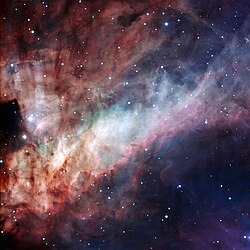Messier Index/M17
The Omega Nebula, also known as the Swan Nebula (catalogued as Messier 17 or M17 and as NGC 6618) is an w:H II region in the w:constellation Sagittarius. It was discovered by w:Philippe Loys de Chéseaux in 1745. w:Charles Messier catalogued it in 1764. It is located in the rich w:starfields of the Sagittarius area of the w:Milky Way.
| Omega Nebula | |
|---|---|
 | |
| Observation data: w:J2000 epoch | |
| Type | Emission |
| Right ascension | 18h 20m 26s[1] |
| Declination | −16° 10′ 36″[1] |
| Distance | 5,000-6,000 ly |
| Apparent magnitude (V) | +6.0[1] |
| Apparent dimensions (V) | 11 arcmins |
| Constellation | Sagittarius |
| Physical characteristics | |
| Radius | - |
| Absolute magnitude (V) | - |
| Notable features | - |
| Other designations | M17, NGC 6618, Swan Nebula[1], Sharpless 45, RCW 160, Gum 81 |
The Omega Nebula is between 5,000 and 6,000 w:light-years from w:Earth and it spans some 15 light-years in diameter. The cloud of interstellar matter of which this w:nebula is a part is roughly 40 light-years in diameter. The total w:mass of the Omega Nebula is an estimated 800 w:solar masses.
A cluster of 35 stars lies embedded in the nebulosity and causes the w:gases of the nebula to shine due to radiation from these hot, young stars.
External links
References
- ↑ a b c d "SIMBAD Astronomical Database". Results for NGC 6618. Retrieved 2006-11-16.
